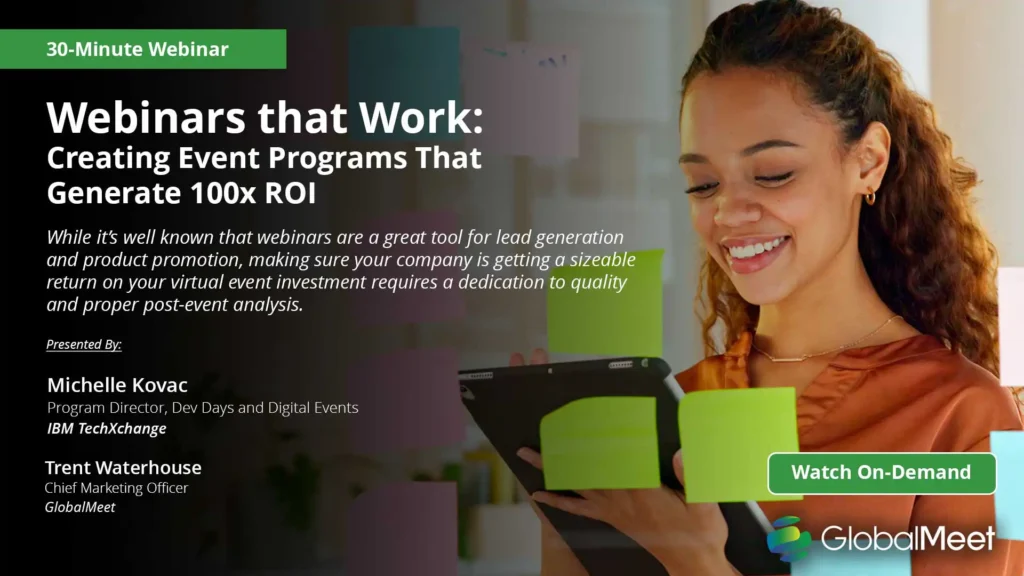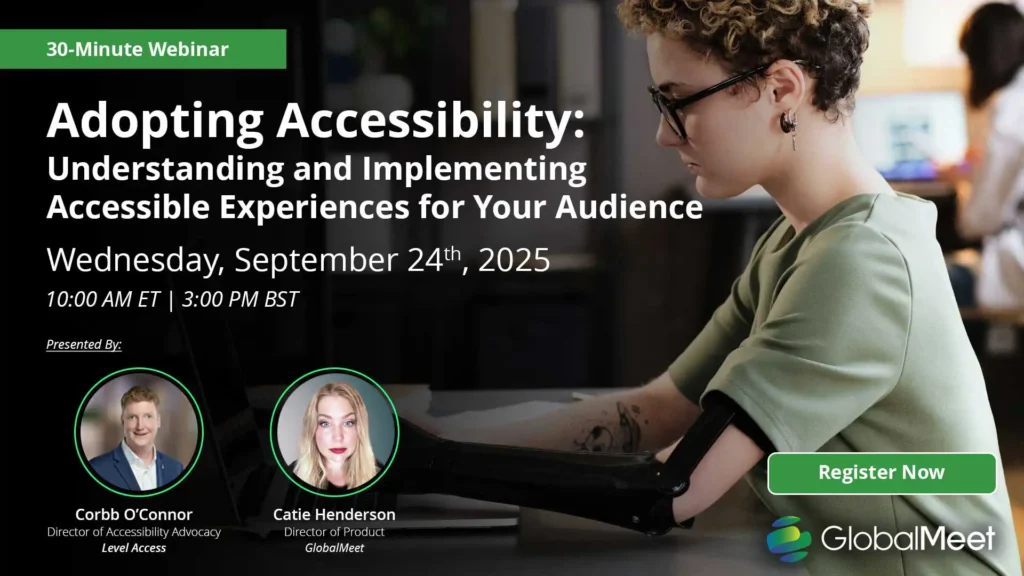
Building Thought Leadership Through Virtual Events
- by GlobalMeet Blog Team
- ,
In today’s digital-first world, establishing thought leadership is essential for businesses and professionals looking to differentiate themselves in competitive markets. Thought leadership is not just about showcasing expertise; it’s about becoming a trusted voice in your industry, driving discussions, and providing valuable insights that others look up to. While traditional methods such as keynote speeches, published articles, and networking events have long been the go-to approaches, virtual events and hybrid formats have emerged as powerful tools for thought leadership. These digital platforms offer a global reach, interactive engagement, and the opportunity to create a lasting impact in ways that in-person gatherings often cannot.
The Role of Virtual Events in Thought Leadership
Virtual events have evolved beyond simple webinars and online meetings. Today they encompass large-scale conferences, interactive workshops, panel discussions, and even immersive virtual networking experiences. Thought leaders can leverage these formats to share insights, connect with audiences, and position themselves as authoritative figures in their field.
The flexibility of virtual events allows industry experts to reach a broader audience, engage in real-time discussions, and showcase their knowledge through dynamic presentations. Whether through a solo keynote, a moderated panel, or a fireside chat, virtual platforms provide the space to deliver high-value content while fostering audience interaction.
Expanding Reach with Hybrid Events
While virtual events are powerful on their own, hybrid events — blending both online and in-person experiences — offer an even greater opportunity to establish thought leadership. Hybrid formats allow for a wider audience while maintaining the benefits of face-to-face interaction. This approach is particularly effective in industries where networking and personal connections play a key role.
By leveraging hybrid events, thought leaders can engage both local and international audiences, ensuring that their insights and expertise reach far beyond the physical limitations of a conference room. Live-streaming keynotes, hosting Q&A sessions that include both in-person and virtual attendees, and offering on-demand content are all ways to enhance engagement and credibility.
Content is King: Crafting a Strong Thought Leadership Narrative
The success of a virtual or hybrid event in building thought leadership depends on the quality and relevance of the content presented. To establish credibility and authority, speakers must deliver insightful, well-researched, and actionable information.
When planning a virtual event, consider these key content strategies:
Know your Audience
Understanding the challenges, interests, and needs of your target audience will allow you to tailor content that resonates with them.
Focus on Innovation and Trends
Thought leadership thrives on fresh ideas and forward-thinking perspectives. Discuss emerging trends, innovative solutions, and industry disruptions to position yourself as a leader.
Storytelling and Case Studies
People connect with stories. Incorporating real-world examples and success stories makes content more relatable and impactful.
Engagement and Interaction
Rather than delivering a one-way speech, encourage participation through live Q&A sessions, polls, and audience-driven discussions.
A strong narrative combined with interactive elements ensures that audiences leave the event feeling informed and inspired.
Leveraging Technology for Maximum Impact
One of the key advantages of virtual events is the ability to utilize advanced technology to enhance the experience. From AI-powered networking tools to virtual reality (VR) environments, technology plays a crucial role in making events more engaging and interactive.
Some tools that can amplify thought leadership efforts in virtual events include:
- Live Streaming Platforms – Services like GlobalMeet allow for seamless presentations and audience engagement, all at the same time.
- Virtual Networking Tools – AI-driven matchmaking platforms connect attendees with similar interests, fostering meaningful discussions.
- Interactive Q&A and Polling Features – the best platforms come equipped with interactive features, allowing event participants to interact in real time.
- On-Demand Content Libraries – Offering recorded sessions post-event extends the lifespan of valuable insights, reaching a wider audience over time.
By incorporating these technological solutions, businesses and professionals can create an immersive and impactful thought leadership experience.
Building Community and Engagement Beyond the Event
A successful thought leadership strategy doesn’t end when the event does. To truly establish authority and maintain credibility, it’s essential to continue engaging with your audience beyond the live sessions.
Consider these post-event engagement tactics:
Follow-up Content
Share key takeaways, insights, and highlights through blog posts, LinkedIn articles, and email newsletters. Providing detailed summaries and expert analysis helps reinforce the key messages delivered during the event and offers additional value to attendees who may want to revisit crucial insights.
Repurpose Content
Turn recorded sessions into short video clips, infographics, or podcast episodes to extend their reach. Creating bite-sized content for different platforms ensures that key messages resonate across a wider audience and increase the longevity of the event’s impact.
Engage on Social Media
Keep the conversation going by encouraging attendees to share their thoughts, tag speakers, and participate in follow-up discussions. Using hashtags, running social media contests, or hosting live chats can help sustain engagement and attract new audiences to the conversation.
Host Smaller, Ongoing Discussions
Webinars, roundtables, and AMA (Ask Me Anything) sessions help maintain momentum and reinforce expertise. Organizing exclusive follow-up events or deep-dive sessions based on attendee feedback can further solidify thought leadership and build a loyal audience.
By nurturing these connections, thought leaders can build a loyal community that looks forward to their insights and contributions.
Measuring Success: How to Track Thought Leadership Impact
To ensure that virtual and hybrid events effectively contribute to thought leadership goals, it’s important to track key metrics that demonstrate influence and engagement. Some critical indicators include:
- Audience Engagement Levels – Monitor participation in live Q&A sessions, chat discussions, and poll responses.
- Content Views and Shares – Analyze the reach of recorded sessions, blog posts, and social media shares.
- Networking and Connections – Assess how many meaningful industry relationships were established through the event.
- Lead Generation and Business Growth – Determine whether the event contributed to new business opportunities, partnerships, or media coverage.
- Feedback and Testimonials – Collect insights from attendees to gauge the impact of your thought leadership efforts.
Regularly reviewing these metrics allows businesses and professionals to refine their virtual event strategies and continuously enhance their industry presence.
Conclusion
Virtual and hybrid events have transformed the way thought leadership is built and sustained. By leveraging these digital platforms, industry experts can share their knowledge with a global audience, foster meaningful discussions, and establish themselves as trusted voices in their fields.
The key to success lies in delivering high-value content, utilizing interactive technology, and maintaining audience engagement beyond the event itself. Whether you’re a business leader, entrepreneur, or industry expert, embracing virtual events as a thought leadership tool can open doors to new opportunities, strengthen credibility, and position you at the forefront of industry conversations.
As virtual and hybrid events continue to evolve, those who strategically use them to share insights and engage audiences will undoubtedly stand out as the leading voices in their industries.


